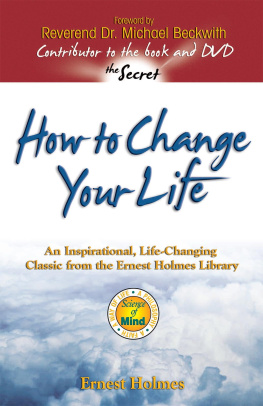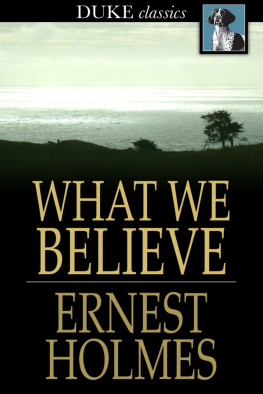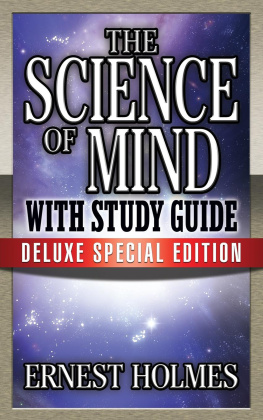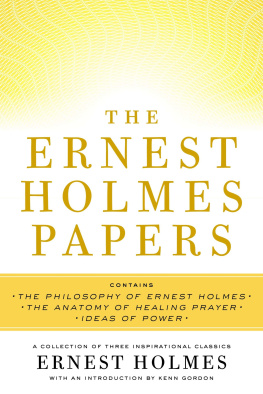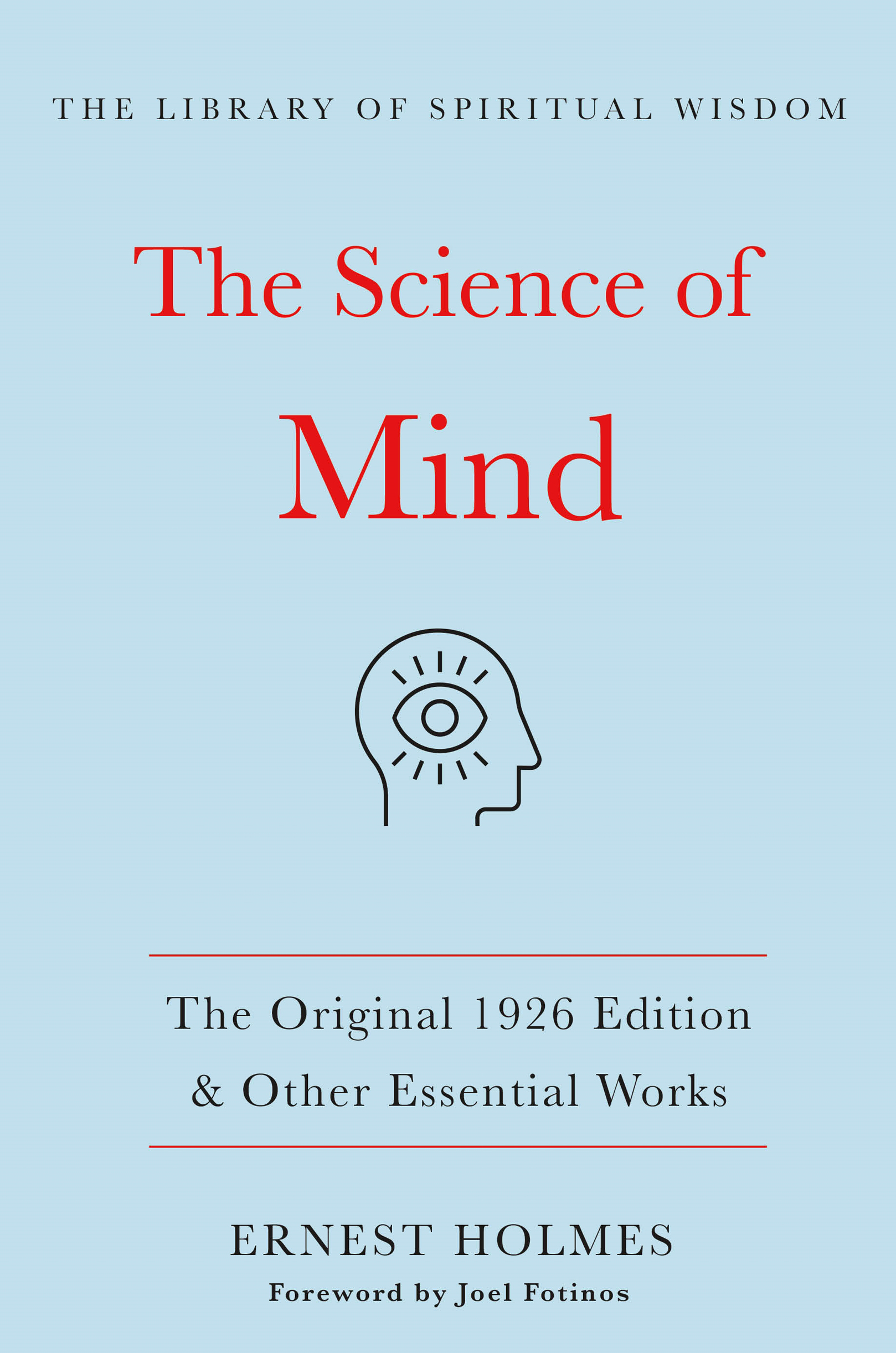Contents
Guide
Pagebreaks of the print version
The author and publisher have provided this e-book to you for your personal use only. You may not make this e-book publicly available in any way. Copyright infringement is against the law. If you believe the copy of this e-book you are reading infringes on the authors copyright, please notify the publisher at: us.macmillanusa.com/piracy.
You are holding a book that has influenced millions of people since its original publication in 1926. The ideas within the book are as current now as they were when it was written and will remain current for generations to come. I first encountered it in a bookstore in Denver, Colorado, in the 1980sI saw a tall stack of thick hardcover books called The Science of Mind. Picking one of the copies up, I flipped through it, and saw it was filled with concepts, ideas, meditations, even charts, all explaining a school of thought that would later change my life. I soon discovered that The Science of Mind is a foundational text in a larger school of philosophy commonly called New Thought.
Ernest Holmes is known as the founder of the Religious Science philosophy, which is largely represented now by the Centers for Spiritual Living (CSL). There are hundreds of CSL Centers around the United States, Canada, Mexico, and more and more around the world.
ERNEST HOLMES
Ernest Shurtleff Holmes was born in 1887 in Lincoln, Maine, and was born into a free-thinking family. At age 15, he moved to Boston where he read Science and Health by Mary Baker Eddy, founder of the Christian Science movement. By all accounts, he had an extremely curious mind and read as many books as he could find, devouring the works of, among many others, Ralph Waldo Emerson, Henry David Thoreau, as well as early New Thought pioneers, such as Warren Felt Evans, Phineas P. Quimby, William Walker Atkinson, Christian D. Larson, and Emma Curtis Hopkins.
Another early influence seemed to be John Bascom, a late-nineteenth- and early-twentieth-century educator and philosopher, who briefly was the president of the University of Wisconsin. He wrote several dozen books with titles such as Natural Theology; Science, Philosophy and Religion; and An Historical Interpretation of Philosophy.
In 1881, Bascom published a book titled The Science of Mind, which reflected his on going adaptation of the ideas of the time with the concepts of religion, philosophy, psychology, and science. He called this philosophy New Theology. You can easily find copies of Bascoms The Science of Mind online, and reading through it, you can see how much it influenced Holmess thought, though Holmes later both simplified and expanded the ideas in Bascoms book.
Holmes eventually moved to California and began work in the city government. He ended up giving a lecture at Los Angeless Metaphysical Library, which ended up being a success. He continued to give lectures, and his audiences grew quickly. He was known for his brilliant mind, his humor, and his enthusiastic oratory skills. He soon traveled around the country giving lectures on the New Thought principles that had become his passion.
In 1919, Holmess first book, a slim volume titled Creative Mind, was published by Robert M. McBride & Company of New York. It contained a series of lectures that Holmes had given during the previous few years. Shortly thereafter, Robert M. McBride & Company published another short book by Holmes, titled Creative Mind and Success, again based on the lectures he gave. Both of those bookscomplete and originalare included in this volume. It is remarkable to read these first books of Ernest Holmes alongside all the subsequent books he published before his death in 1960. So fully formed were the ideas that he shares in these two books, that the same ideas remained in the books throughout his life.
TWO VERSIONS OF THE SCIENCE OF MIND (1926 & 1938)
His audience increased, and eventually Holmes founded the Institute of Religious Science in 1926. This was the same year that Robert M. McBride & Company published Holmess third book, The Science of Mind, a book which later became commonly referred to as the textbook. It was Holmess magnum opus, the overview of Religious Science. It expanded on his earlier books, and it met with early success, being reprinted several times in the first couple of years after it was published.
Twelve years after he published the first edition of the book you are holding now, he published a revised and expanded edition of The Science of Mind with the assistance of Maude Allison Lathem, a longtime editor of the Institutes magazine, Science of Mind magazine, which is still being published to this day. This new edition, which is still used as the main textbook in many CSL Centers, added sections about spiritual thought and Jesus. It was more organized and clearly meant to be used in the classes of the Institute.
While much of the material from the 1926 edition was retained, much of it was also edited out. For example, Holmes removed nearly all of Lesson Six: Psychic Phenomena. This lesson, which is faithfully included in this edition, contains Holmess thoughts and teachings about subjects such as telepathy, apparitions, trances, psychic capacities, ghosts, clairvoyance, psychometry, black magic, crystal gazing, and more. Holmes continued to believe in these subjects, but edited them out of the later 1938 edition as he felt they were being developed into their own science of study.
He also removed some of the Special Articles in his later edition, including those on sexuality, male and female psyches, psychoanalysis, and emotions. Many people have noticed that in this original 1926 edition, many of Holmess ideas, which would have been forward thinking at the time of publication, are remarkably in line with current human thought. One need only read his section on Male and Female and see how advanced and ahead of his time Holmes was.
Another change from this original edition to the later 1938 edition is that much of Holmess teaching voice had changed. This makes the later 1938 edition less personal and urgent than the 1926 edition. Reading through this original edition, you can almost feel Holmess excitement at the ideas he is sharing. While the 1926 and 1938 editions share a title and some material, they are two distinct books, and both deserve to be read.
THE ORIGINAL 1926 EDITION
The original 1926 edition itself is arranged in several parts. Part One is Holmess introduction to the Religious Science philosophy. In this section, he makes the case of the evolution of thought and how metaphysics is expressing the highest ideal yet for humankind. He uses science, art, psychology, religion, philosophy, and more to substantiate his claims.
Holmes never claimed to receive direct revelations or any special divine knowledge. He believed that all traditions and disciplines could contain revelatory truths that could make life more complete. He blended the best of all of those disciplines listed in the previous paragraph into his philosophy and frequently would say that even the Religious Science philosophy was evolving. He called it being open at the top, meaning to take the best ideas available at the time, but always remain open to more ideas and new concepts.
Part Two contains the six metaphysical lessons. In them, one can see the structure of how he would teach these lessons to his students. To make sure each idea was made clear to readers, each concept was explained thoroughly through glossaries, charts, introductions, and recapitulations.


